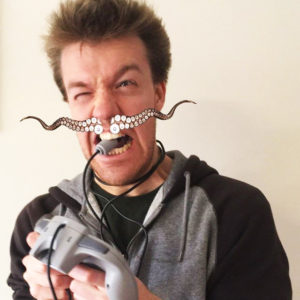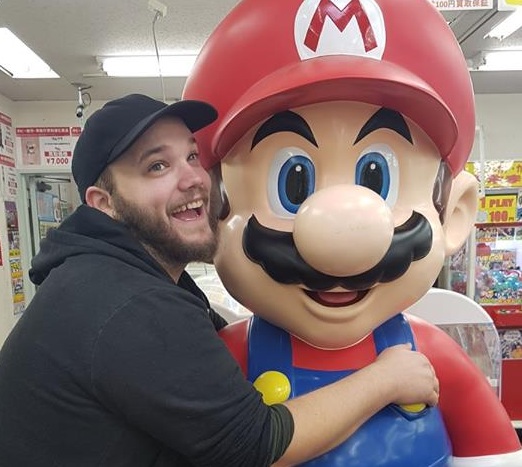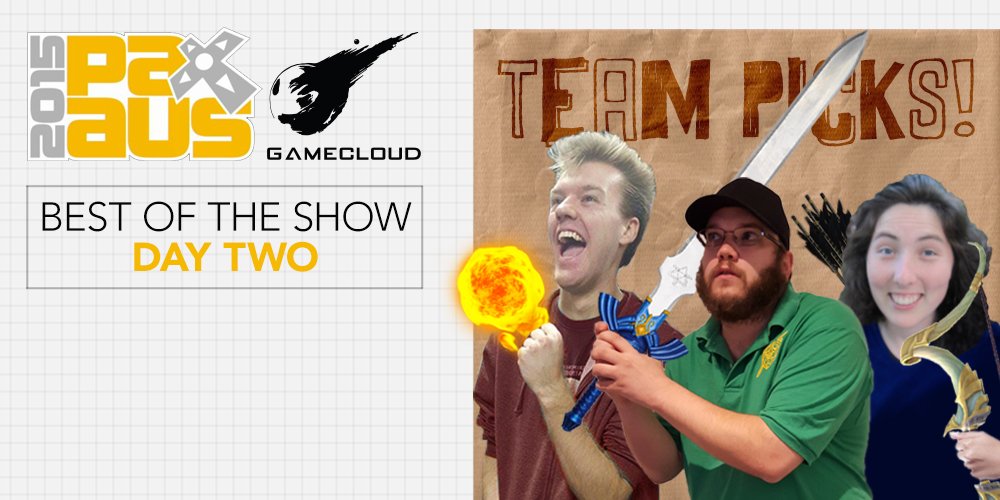
The weekend has landed and day two of PAX saw the halls of the Melbourne Exhibition Center overflowing with gaming enthusiasts of all varieties! Once more unto the breach we unleashed our fearless reporters – Nick, Paddy and Ellis – to take in the sights, sounds, and the occasional unfortunate smell. Now that day two has come to a close, they’re bringing to you the very best (or so they think) that PAXAus 2015 had to offer. We had to talk Paddy down from gushing about Battleborn again.
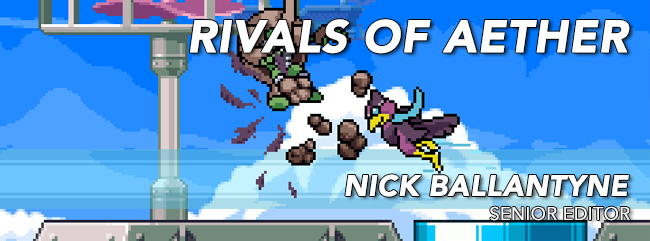
When I first looked at Rivals of Aether, I almost discounted it as a Smash Bros clone for furries. Once I looked past the far too cuddly animals, it suddenly hit me: This game rocks more socks than most Zettai Ryouiki models. It’s a brawler mixed with a fighter, like Smash Bros cum Skullgirls, and once I realised what I was doing, I dug everything I saw. Don’t be deceived by the erotic animals, there’s more to this game than bios and anthropomorphism – it’s an interesting game here too!
It’s hard not to compare this to Smash Bros because that’s basically what it is, but it feels very different to any Smash game I’ve ever played. The movements are less floaty, more precise and require more care than spamming Zelda’s forward-B. The other main difference is that all characters have abilities that persist beyond punching and jumping. I could make a plant in the ground with the squirrel, and it would stay there until I used it for another ability. This made positioning a vital component to the game, and that gave it a unique dynamic that most brawlers shy away from.
This permanence of your abilities means chaining together your moves to knock your opponent off the edge can go from hitting hard to hitting smart. If you have something planted on one edge of the field, you can use it after whacking your opponent towards it and ultimately deliver the final blow. One character could use an ability to make an illusory clone of himself, but it still damaged you, and whether or not you used it to your advantage could make it a useless copy or an effective bashing tool.
I won’t say that I’m a huge fan of the game’s art style, but each character felt incredibly unique, from concept to execution. Each one moved at different speeds, attacked in vastly different fashions, and I don’t think a single ability felt like it came from another character. It is just a bunch of standing animals blindly whacking one another, but each animal had a unique feel, the whacking felt nuanced, and it didn’t feel like a Smash rip-off. I was impressed, to say the least.
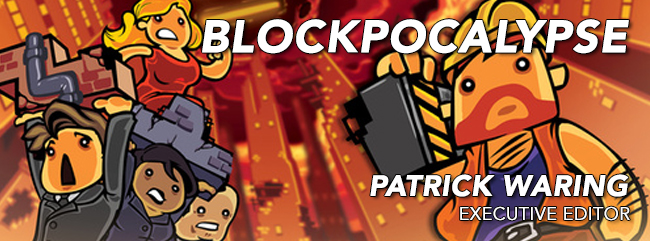
I’m not going to lie, when I first saw Blockpocalypse I thought it looked a little lame. It’s a pixel graphic runner game that throws players into a struggle for survival when the Majora’s Mask moon comes crashing down to Earth. As lava rises, players use the debris that’s lying around to build make-shift towers, climb the inexplicably floating platforms, and reach a helicopter. It’s not exactly groundbreaking stuff. Because of my infatuation with pixel graphics, and the saturation of such titles on the market right now, I’ve become more discerning with what I play. I turned my nose up at it before PAX had even begun.
Crossing the expo hall in the spare moment of my day looking for something to play, since I couldn’t write about Battleborn again, I heard a familiar noise. It was the anguished cries of someone who’d been betrayed by someone they trust: “FUCK YOU WIGGLES,” was what the voice was shouting. I was intrigued. Finding Nick along the way, I dragged him over to this apparent shrine to sudden treachery and was treated to what will become my new fave game. (Until people stop playing with me.) Your goal might be to survive, and you certainly require your teammates to do that in Blockpocalypse, but that doesn’t mean you can’t be a dick.
I’m sure this will come as a shock to absolutely no one, but screwing people over in games is something I take great joy in perpetrating. “Griefing,” is something I’ve taken to art form levels because nothing causes grief like the sting of someone you trust stabbing you in the back. Nick trusted me in the beginning, stacking objects together along side me in the mutual understanding that we’d soon be free of this hellish nightmare. I’m sure he believed that’s exactly what would happen, too, until the fateful moment came. “Nick,” I said, throwing our last block into the lava below, “we’re short a brick, and we can’t reach the next platform. Jump on me and I’ll throw you over.”
No sooner had he landed in my hands was he hurtling off the edge and towards a fiery death. The deed was done and a dark joy filled my soul as I pointed and laughed at Nick. Not LoL, or Smite, nor AssCreedSyn or Battleborn could drown out the sound of my maniacal cackling as Nick walked away in disgust. GOD, I’m lonely.
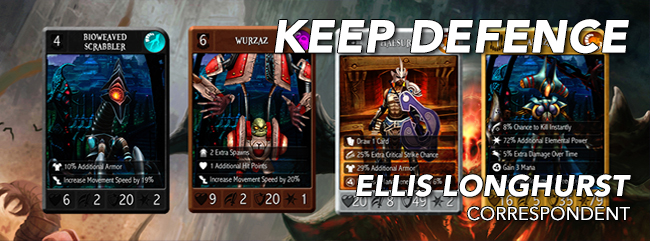
Have you ever wished that your trading cards came to life, a la YuGiOh? Well, before virtual or augmented reality devices tick that dream off the list, Grantley Day and his team at Good Games Productions, have you covered with their latest title – Keep Defence.
I have a lot of involvement with the competitive Pokemon Trading Card scene and a strong desire to defend my home if necessary (see childhood/teenage influences such as Home Alone and Plants vs Zombies). So when an email in ye olde inbox with the words ‘collectible card game’ and ‘tower defense’ popped up, I knew this was a production that was not to be overlooked. I caught up with creator and veteran of the video game industry, Grantley Day.
“Keep Defence is a hybrid collectible-card tower-defense game,” he says, “you construct a deck with your cards then play an action game in an isometric 2.5d view.”
In online multiplayer one player acts as the attacker, playing creature cards from their deck onto one of few spawn points, causing said creatures to materialise and make a beeline for an orb situated in the middle of the map. The opposing player has a deck with heroes and spells, and are able to place heroes anywhere on the map where they act as immovable towers, using their abilities to destroy enemy creatures in sight. When the orb has been destroyed, the two players swap roles and the process repeats. The winner is the player who destroyed the orb in the quickest time.
“I was annoyed by the turn-based nature of trading card games, so this is a real time trading card game!” Day explains. “The games are over in a couple of minutes, but there is still a lot of strategy involved – it comes down to the placement of heroes, and the use of spawn points. This game rewards players who can think quickly.”
In addition to an online multiplayer, the game will have a 40-hour single player campaign that will teach players all the mechanics and be asymmetrical in nature (you play as attack and defence at different times throughout the campaign). Further features include a map editor, card customisation (cards level up and unlock new features, with gold earned in-game being used to further alter these features), and an online ELO rating system.
The concept is novel, and the game was conceived by a team well-versed in the art of trading card games; Day himself grew up playing Magic: The Gathering and followed the evolution of Hearthstone closely. The game design is solid, and there is clearly an awareness of the potential problems that trading card games can encounter such as unbalanced mechanics, etc. Keep Defence will launch on Steam Greenlight in 2 weeks time, before a release on PC and Mac in February of 2016. For now I suggest dropping by the Good Game Productions booth (across from Nintendo) at PaxAus to test a pre-alpha copy of the game and receive a code for special in-game perks!

